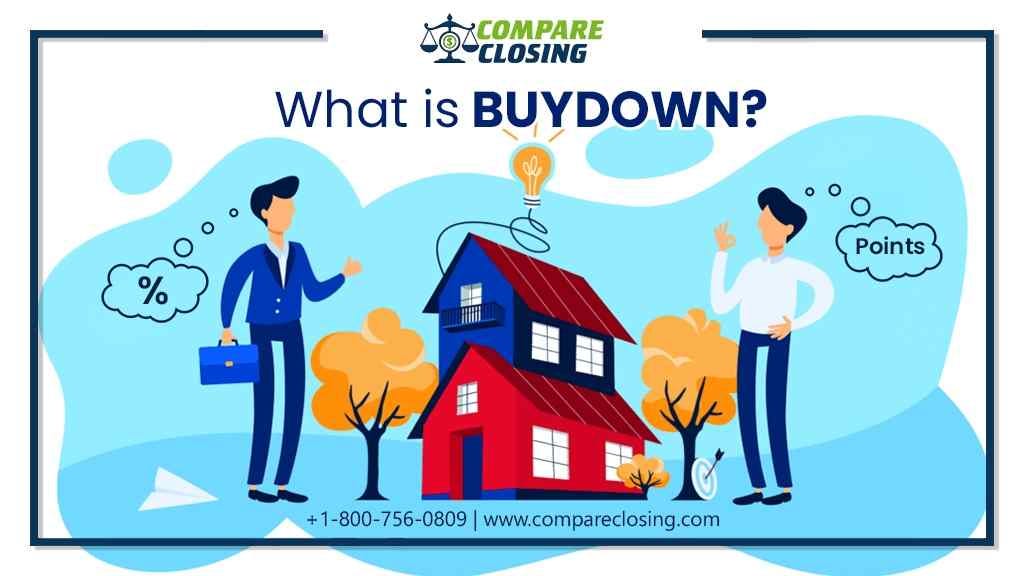
About Buydown
When it comes to getting a mortgage or refinancing the current mortgage, the interest rate is one of the key factors to decide if the whole transaction is worth going ahead with.
You not only pay for your home, but you also have to pay for the lending service that helps you to purchase the home.
Mortgage interest rates are always fluctuating and hence it could be sometimes confusing whether to buy a new home or refinance at a certain point.
However, there is one option where you can decide what interest rate you want for your mortgage. It’s called a mortgage buydown. In this post, we will learn about buydown mortgage and how it works.
What is Buydown Mortgage?
A buydown is a home loan financing method where the purchaser tries to get a lower rate of interest.
In the buyer’s market, the seller normally pays the lender buydown mortgage points to the lender which brings down the buyer’s rate of interest on the mortgage, resulting in lower monthly payments.
In the case of refinancing, the borrower can use the buydown mortgage to lower the interest rate by paying upfront points.
Points or Discount points are fees charged by the lender upfront so that you can get a lower interest rate. One point equals one percent of the total loan amount.
The points could be paid by any one of the parties depending on the sales contract, Buyer, Seller, builders, or borrowers who are refinancing their mortgage.
The borrower will get the benefit from the buydown by paying the points to the lender in exchange for a lower rate.
Some buy downs have expiration in which the buydown rate expires after a few years, where the borrower needs to pay the standard interest rate.
This causes the monthly payments to increase for the borrower once the buydown rate expires.
What are the Types of Buydown Mortgages?
There are 3 types of buydown mortgages.
- 3–2–1 Buydown Mortgage.
- 2–1 Buydown Mortgage.
- Fully Amortized Buydown Mortgage.
3–2–1 Buydown Mortgage:
The 3–2–1 buydown mortgage is a form of loan that begins with a low-interest rate and gradually increases over the course of many years until it reaches its final interest rate as per the market standard.
When a borrower uses this buydown that gets reduced interest rates for the first 3 years in exchange for making an upfront payment in form of points.
In general 3–2–1 buydown mortgages are only accessible for primary and secondary homes and not for investment properties.
In addition to that, the 3–2–1 buydown is not accessible as a part of an adjustable-rate mortgage (ARM) with an initial term of fewer than 5 years.
In this form of buydown mortgage, the interest rate on the loan is reduced by 3% on the first year, 2% in the second year, and 2% in the third year of the loan’s existence.
From the fourth year onwards, the loan’s permanent interest rate is applied for the remainder of the loan’s duration.
2–1 Buydown Mortgage:
If the interest rate is bought by 2–1 buydown mortgage, it is dropped by 2% in the first year, 1% in the second year, and then returns to its original interest rate when the buydown period expires.
Fully Amortized Buydown Mortgage:
In most cases, the borrower will buy down the interest rate using a fully amortized buydown mortgage.
In this form of buydown, the borrower pays an upfront amount as discount points to get the lower interest rate for the entire tenure of the loan.
This ensures that the monthly payment on the mortgage never increases till the life of the loan.
Conclusion
Buydown can be a fantastic option once you do your math and understand the breakeven point for recouping the money that you are putting down upfront for buying down the interest rate.
If you are in a situation where the seller or the builder is ready to pay for the points at closing, buying down could make a lot of sense as it will help you save money over the course of your loan.
If you are the one who is going to pay for the points, it is suggested to ask your lender both the options, one with points and the other without points, and see how much time it is going to take for you to recover the money that you are going to invest.
If you are planning to reside in the house for more than the time it is taking for you to recover, then buying down would make sense.
If you are planning to refinance or sell the house within the time it would take you to recover the points, you might want to reconsider your option for buying down the points.
https://www.compareclosing.com/blog/guide-to-mortgage-buydown/
Comments
Post a Comment